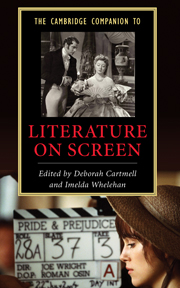Book contents
- Frontmatter
- Introduction - Literature on screen: a synoptic view
- Part One Theories of Literature on Screen
- Part Two History and Contexts
- 3 Gospel narratives on silent film
- 4 William Shakespeare, filmmaker
- 5 The nineteenth-century novel on film: Jane Austen
- 6 Modernism and adaptation
- 7 Postmodern adaptation: pastiche, intertextuality and re-functioning
- Part Three Genre, Industry, Taste
- Part Four Beyond the "Literary"
- Further reading
- Index
- Series List
7 - Postmodern adaptation: pastiche, intertextuality and re-functioning
from Part Two - History and Contexts
Published online by Cambridge University Press: 28 September 2007
- Frontmatter
- Introduction - Literature on screen: a synoptic view
- Part One Theories of Literature on Screen
- Part Two History and Contexts
- 3 Gospel narratives on silent film
- 4 William Shakespeare, filmmaker
- 5 The nineteenth-century novel on film: Jane Austen
- 6 Modernism and adaptation
- 7 Postmodern adaptation: pastiche, intertextuality and re-functioning
- Part Three Genre, Industry, Taste
- Part Four Beyond the "Literary"
- Further reading
- Index
- Series List
Summary
Average film-goers probably take more notice of a film's stars than of its director. Stars or actors are, after all, visible on screen for approximately two hours whereas the director merely fronts or ends the credits. How many viewers, for example, know the directors of the Bridget Jones films (Sharon Maguire and Beeban Kidron) compared with those who know its stars, Colin Firth, Hugh Grant, and Renée Zellweger? When you read a novel you hold the author's name in your hands, touching it with your finger-tips, and what you see in reading are their words. But when a film is “based on the book, story or play by . . .,” then the author's name tends also to recede along with their text, even such a one as Helen Fielding, J. R R. Tolkien, Jane Austen, or Shakespeare. The process is, we might say, a technologically-induced version of the “death of the author” theorized by Roland Barthes in the 1960s. Barthes's intention was to demote the godlike figure of the (usually male designated) “Author” to the figure of a “scriptor” working laterally across texts, and to activate the reader, similarly, as a figure who cruised, antennae bristling, across this layered textuality, but did not pause to dig below or look behind this surface for a book's single authorized meaning. Barthes's essay, along with other theoretical essays in the same decade, by Julia Kristeva, for example, inaugurated the concept of intertextuality and the practice of intertextual reading. This was one of the major strategic features of poststructuralism and is a continuing touchstone in the Humanities. At the same time, we cannot fail to notice, almost fifty years after Barthes's essay, that in the world of everyday reading, book reviews, as well as much academic criticism, the author is as strong a presence as ever.
- Type
- Chapter
- Information
- The Cambridge Companion to Literature on Screen , pp. 107 - 120Publisher: Cambridge University PressPrint publication year: 2007
- 6
- Cited by

